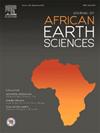Spatiotemporal variability of the Cenomanian macrobenthic fauna in Northeast Algeria: Species versus community level variations
IF 2.2
4区 地球科学
Q2 GEOSCIENCES, MULTIDISCIPLINARY
引用次数: 0
Abstract
Environmental changes can impact benthic fauna at multiple levels. To better understand these changes at both the species and community levels, the Cenomanian macrofossils from two regions in northeastern Algeria, Tébessa and Batna, were analyzed. The results revealed that while changes at the species level (morphology) and community level (ecology) followed similar patterns, they were not identical. Non-metric multidimensional scaling (NMDS) and permutational multivariate analysis of variance (PERMANOVA) tests of the morphological variations of 114 complete shells of the suspension-feeding trigonoid bivalve Scabrotrigonia scabra (Lamarck, 1819) showed significant differences (P < 0.001) between the two regions. Two distinct echophenotypes were identified, with the first dominating in Tébessa and the second in Batna. The Batna echophenotype is characterized by smaller, flattened shells with numerous ribs, an adaptive strategy for stabilizing in soft substrates. Additionally, the smaller shells in Batna were linked to the oligotrophic conditions of the outer ramp setting, in contrast to the deeper outer ramp setting in Tébessa (mesotrophic). To further investigate environmental variations, the macrofaunal associations of the Cenomanian were examined. The NPMANOVA test indicated significant differences in faunal associations between the regions, with Batna exhibiting less diversity and a higher proportion of deposit-feeders, suggesting soft substrate conditions. In contrast, no significant differences were found among the faunal associations of the different Cenomanian substages, though ecological attributes showed minor, gradual changes. The early and middle Cenomanian fauna were dominated by epifaunal byssate taxa, while deposit-feeder taxa increased in the late Cenomanian, likely due to the global sea-level rise toward the end of the period. Overall, the paleogeographic setting (middle versus outer ramp) appears to have played a major role in shaping the ecological and morphological variations between Tébessa and Batna.
阿尔及利亚东北部塞诺曼尼亚大型底栖动物的时空变异:物种与群落水平的差异
环境变化可以在多个层面上影响底栖动物。为了更好地了解这些变化在物种和群落水平上的变化,我们对阿尔及利亚东北部两个地区(tsambessa和Batna)的Cenomanian宏观化石进行了分析。结果表明,物种水平(形态)和群落水平(生态)的变化模式相似,但并不完全相同。对悬浮性三角鱼双壳(Lamarck, 1819) 114个完整壳的形态差异进行非度量多维标度(NMDS)和置换多变量方差分析(PERMANOVA)检验,结果显示存在显著差异(P <;0.001)。鉴定出两种不同的回声表型,第一种在tsambessa占主导地位,第二种在Batna占主导地位。Batna回声型的特点是具有许多肋骨的较小,扁平的外壳,这是一种在软基质中稳定的适应性策略。此外,Batna较小的贝壳与外斜坡环境的寡营养条件有关,与tsambessa较深的外斜坡环境(中营养)相反。为了进一步研究环境变化,研究了塞诺曼尼亚人的大型动物关联。NPMANOVA检验表明,各地区之间的动物关联存在显著差异,Batna表现出较少的多样性和较高的沉积物食用者比例,表明软基质条件。相比之下,尽管生态属性表现出轻微的渐进变化,但在不同的塞诺曼尼亚亚阶段的区系关联中没有发现显著差异。早、中期塞诺曼尼亚动物群以脚底垫类为主,而晚塞诺曼尼亚动物群则有所增加,这可能是由于该时期末期全球海平面上升所致。综上所述,古地理环境(中斜坡与外斜坡)在形成tsambessa和Batna之间的生态和形态差异方面发挥了主要作用。
本文章由计算机程序翻译,如有差异,请以英文原文为准。
求助全文
约1分钟内获得全文
求助全文
来源期刊

Journal of African Earth Sciences
地学-地球科学综合
CiteScore
4.70
自引率
4.30%
发文量
240
审稿时长
12 months
期刊介绍:
The Journal of African Earth Sciences sees itself as the prime geological journal for all aspects of the Earth Sciences about the African plate. Papers dealing with peripheral areas are welcome if they demonstrate a tight link with Africa.
The Journal publishes high quality, peer-reviewed scientific papers. It is devoted primarily to research papers but short communications relating to new developments of broad interest, reviews and book reviews will also be considered. Papers must have international appeal and should present work of more regional than local significance and dealing with well identified and justified scientific questions. Specialised technical papers, analytical or exploration reports must be avoided. Papers on applied geology should preferably be linked to such core disciplines and must be addressed to a more general geoscientific audience.
 求助内容:
求助内容: 应助结果提醒方式:
应助结果提醒方式:


